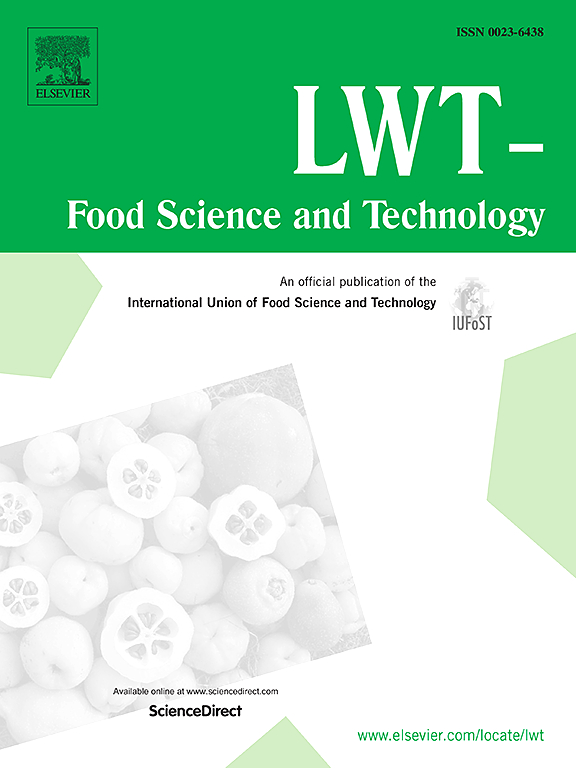Enhanced extraction of procyanidins from avocado processing residues by pulsed electric fields pre-treatment
IF 6
1区 农林科学
Q1 FOOD SCIENCE & TECHNOLOGY
引用次数: 0
Abstract
The waste generated by the global production of avocado (Persea americana Mill), which includes peels, seeds, and pulp, poses environmental challenges. The principles of circular economy offer a sustainable solution by valorizing this waste and transforming it into valuable products. This study investigates the potential of avocado by-products, particularly peels and seeds, as a source of procyanidins. Pulsed electric field (PEF) technology has been shown to increase the extraction yield of valuable compounds from food waste/losses. In our study, we optimized the PEF treatment of avocado peels and seeds for the extraction of procyanidins by using Box-Behnken designs with response surface methodology and desirability functions. The effects evaluated were the frequency (1, 50, 100 Hz), the electric field strength (0.8, 1.1, 1.5 kV/cm) and the number of pulses (100, 150, 200) for avocado peel, while for the avocado seeds were the frequency (50, 100, 150 Hz), the electric field (0.6, 0.7, 0.8 kV/cm) and the total operating time (1, 5, 10 s). Our study showed that the procyanidin content measured by HPLC-FLD significantly increased in PEF-pretreated avocado peel and seeds. The optimized treatment conditions include a frequency of 50 Hz, an electric field strength of 1.31 kV/cm, and 175 electric pulses for the avocado peels, resulting in a procyanidin content of 9798.32 ± 103.83 μg CE/g d.w. For avocado seeds, the optimal conditions include a frequency of 100 Hz, an electric field strength of 0.75 kV/cm, and total operating time of 5.5 s, resulting in a procyanidin content of 21103.12 ± 234.76 μg/g d.w. The precision and validity of the mathematical models confirmed the reliability of these optimal conditions. These results emphasize the potential of PEF technology for the extraction of procyanidin from avocado waste and contribute to environmentally friendly extraction techniques in the food industry.
通过脉冲电场预处理提高鳄梨加工残渣中原花青素的提取率
全球牛油果(Persea americana Mill)生产过程中产生的废弃物(包括果皮、种子和果肉)给环境带来了挑战。循环经济原则提供了一种可持续的解决方案,即对这些废弃物进行估价并将其转化为有价值的产品。本研究调查了牛油果副产品(尤其是果皮和种子)作为原花青素来源的潜力。研究表明,脉冲电场(PEF)技术可提高从食物废料/损失中提取有价值化合物的产量。在我们的研究中,我们利用箱-贝肯设计、响应面方法和可取函数,对牛油果皮和种子的 PEF 处理进行了优化,以提取原花青素。对牛油果皮的影响是频率(1、50、100 Hz)、电场强度(0.8、1.1、1.5 kV/cm)和脉冲数(100、150、200),而对牛油果籽的影响是频率(50、100、150 Hz)、电场(0.6、0.7、0.8 kV/cm)和总运行时间(1、5、10 s)。我们的研究表明,用 HPLC-FLD 测量的原花青素含量在经 PEF 预处理的牛油果果皮和种子中明显增加。优化的处理条件包括:频率为 50 Hz,电场强度为 1.31 kV/cm,电脉冲次数为 175 次,牛油果果皮的原花青素含量为 9798.32 ± 103.83 μg CE/g d.w。对于牛油果种子,最佳条件包括频率为 100 Hz、电场强度为 0.75 kV/cm、总操作时间为 5.5 s,结果原花青素含量为 21103.12 ± 234.76 μg/g d.w。数学模型的精确性和有效性证实了这些最佳条件的可靠性。这些结果凸显了 PEF 技术在从牛油果废料中提取原花青素方面的潜力,并为食品工业中的环境友好型提取技术做出了贡献。
本文章由计算机程序翻译,如有差异,请以英文原文为准。
求助全文
约1分钟内获得全文
求助全文
来源期刊

LWT - Food Science and Technology
工程技术-食品科技
CiteScore
11.80
自引率
6.70%
发文量
1724
审稿时长
65 days
期刊介绍:
LWT - Food Science and Technology is an international journal that publishes innovative papers in the fields of food chemistry, biochemistry, microbiology, technology and nutrition. The work described should be innovative either in the approach or in the methods used. The significance of the results either for the science community or for the food industry must also be specified. Contributions written in English are welcomed in the form of review articles, short reviews, research papers, and research notes. Papers featuring animal trials and cell cultures are outside the scope of the journal and will not be considered for publication.
 求助内容:
求助内容: 应助结果提醒方式:
应助结果提醒方式:


